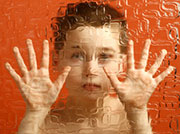
TUESDAY, Jan. 14, 2014 (HealthDay News) — Doctors and parents have long struggled to understand the strange sensory tricks autism can play on a child’s mind. Ordinary noises — screeching car alarms, knocking radiator pipes, even the whirr of a fan — can be intolerable to children with the neurodevelopmental disorder.
Now, a new study involving 64 children offers fresh clues about why sounds may unnerve kids with autism.
The study, published Jan. 14 in the Journal of Neuroscience, found that children with autism experience delays when their brains attempt to process information received by their eyes and their ears at the same time.
As a result, they have trouble matching sounds, especially speech, to their sources.
“They’re perceiving the world in a really interesting and fragmented way, where the visual signal and auditory signal are sort of mismatched in time relative to one another,” said study author Mark Wallace, director of the Vanderbilt Brain Institute in Nashville, Tenn.
Wallace said it would be like watching a badly dubbed foreign film.
“And if you think about it, that can have all kinds of consequences for the language abilities of these children and even their social interactions,” he said.
In the United States, it’s estimated that one in 88 children has some form of autism. The main signs include repetitive behaviors and problems with communication, social interactions and sensory processing. Some kids on what is called the “autism spectrum” may have mild symptoms, as in Asperger syndrome, while others have full-blown autism.
For the study, researchers compared 32 children with an autism spectrum disorder to 32 normally developing children. The children, who were between 6 and 18 years old, were matched by age and by their scores on intelligence tests.
Researchers had them sit at computer monitors in a dimly lit, sound-proof room. Then they presented them with a series of sights and sounds, like a bright flash with a pop, a clang as a virtual hammer hit a nail, and the sounds “bah” or “gah” with moving lips. Researchers changed the interval between the sight and the sound ever so slightly between each test. The kids were asked to say when they happened together and when they were separated.
Wallace said that normally it takes the brain about a quarter of a second to identify sights and sounds that belong together. But the researchers found that for kids with autism it takes about twice as long, about half a second. As a result, he said, the brain can’t successfully pair sights and sounds. That problem seemed to be most acute for speech.
“It’s going to create a very confusing and overwhelming view of the world around them,” he said.
Experts who were not involved in the research said the results were intriguing.
“It’s pretty fascinating. This type of information goes a long way in helping parents understand their children’s problems,” said Dr. Patricia Manning-Courtney, a pediatrician who treats children with autism at Cincinnati Children’s Hospital Medical Center in Ohio.
Dr. Andrew Adesman, chief of developmental and behavioral pediatrics at Steven & Alexandra Cohen Children’s Medical Center of New York in
New Hyde Park, said the findings not only suggest a new line of clinical research investigation but may also suggest a novel treatment approach focusing on perceptual training.
“Although it is premature to know whether the findings from this study will indeed lead to one or more new avenues of clinically significant research, the results do raise some interesting and potentially important questions about the relationship between autism spectrum disorders and deficits in the processing of complex sensory stimuli,” said Adesman.
More information
Visit the U.S. Centers for Disease Control and Prevention.for more on autism.
Copyright © 2025 HealthDay. All rights reserved.

